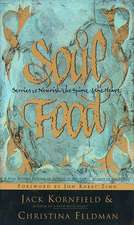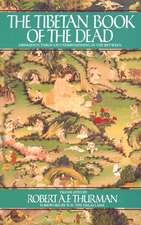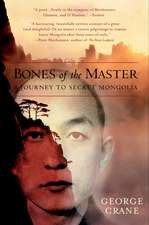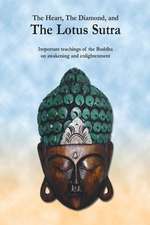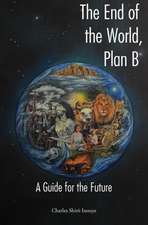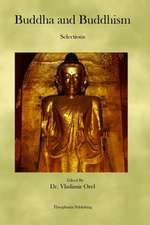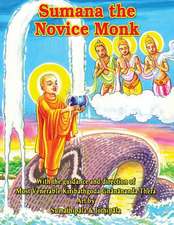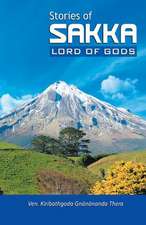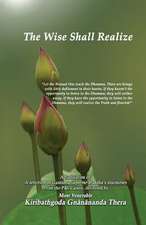After the Ecstasy, the Laundry: How the Heart Grows Wise on the Spiritual Path
Autor Jack Kornfielden Limba Engleză CD-Audio – 31 mai 2005
When does enlightenment come? At the end of the spiritual journey? Or the beginning? On "After the Ecstasy, the Laundry," Jack Kornfield author of the modern classic on American Buddhism, "A Path with Heart" brings into focus the truth about satori, the awakened state of consciousness, and enlightenment practices today.
"Perfect enlightenment" appears in many texts, Kornfield begins. But how is it viewed among Western teachers and practitioners? To find out, Kornfield talked to more than 100 Zen masters, rabbis, nuns, lamas, monks, and senior meditation students from all walks of life.
The result is this extraordinary look at the hard work we all must do the laundry no matter how often we experience ecstatic states of consciousness through meditation and other disciplines.
Sweeping in scope, and warmly told by one of American Buddhism's most trusted voices, "After the Ecstasy, the Laundry" is a work of both deep inspiration and daily instruction that cuts through the confusion about what enlightenment really is, who it comes to, and how it continues to inform and guide our spiritual lives.
An original audio adaptation of Jack Kornfield's book, "After the Ecstasy, the Laundry."
Course objectives: Assess how to embrace the joys and sorrows of everyday life after experiencing a transcendent spiritual awakeningIntegrate inner knowledge with outer expression and experienceAnalyze how to embrace spiritual practice as an invitation to the truthPlan to embrace our human feelings without judgmentDescribe how to recognize the Buddha in each other and create community"
| Toate formatele și edițiile | Preț | Express |
|---|---|---|
| Paperback (2) | 96.18 lei 3-4 săpt. | |
| Bantam – 30 sep 2001 | 96.18 lei 3-4 săpt. | |
| Ebury Publishing – 22 iun 2000 | 101.71 lei 24-30 zile | +37.35 lei 5-11 zile |
Preț: 248.13 lei
Nou
47.49€ • 49.39$ • 39.20£
Indisponibil temporar
Specificații
ISBN-10: 1591793947
Dimensiuni: 134 x 147 x 27 mm
Greutate: 0.23 kg
Ediția:Revised
Editura: SOUNDS TRUE INC
Locul publicării:United States
Notă biografică
Extras
The moment I heard my first story
I started looking for you....
– Rumi
Midway along our road of life I woke to find myself standing alone in a dark wood.
– Dante Alighieri
What is it that draws a person to spiritual life? From as far back as we can remember, we can each sense a mystery in being alive. When we are present with an infant in the first moments after birth, or when the death of a loved one brushes close to us, the mystery becomes tangible. It is there when we witness a radiant sunset or find a moment’s silent stillness in the flowing seasons of our days. Connecting to the sacred is perhaps our deepest need and longing.
Awakening calls to us in a thousand ways. As the poet Rumi sings, “Grapes want to turn to wine.” There is a pull to wholeness, to being fully alive, even when we have forgotten. The Hindus tell us that the child in the womb sings, “Do not let me forget who am,” but that the song after birth becomes, “Oh, I have forgotten already.”
Still, as surely as there is a voyage away, there is a journey home.
Throughout the world we find stories of this journey, images of the longing to awaken, the steps along the path that we all follow, the voices that call, the intensity of the initiation we may meet, the courage we need. At the heart of each is the original sincerity of the seeker, who must honestly admit how small is our knowledge of the universe, how great the unknown.
The honesty the spiritual quest requires of us is addressed in the Russian initiation tales about Baba Yaga. Baba Yaga is an old woman with a wild, haglike visage who stirs her pot and knows all things. She lives deep in the forest. When we seek her out we are frightened, for she requires us to go into the dark, to ask dangerous questions, to step outside the world of logic and comfort.
When the first young seeker comes quaking up to the door of her hut, Baba Yaga demands, “Are you on your own errand or are you sent by another?” The young man, encouraged in his quest by his family, answers, “I am sent by my father.” Baba Yaga promptly throws him into the pot and cooks him. The next to attempt this quest, a young woman, sees the smoldering fire and hears the cackle of Baba Yaga. Baba Yaga again demands, “Are you on your own errand or are you sent by another?” This young woman has been pulled to the woods alone to seek what she can find there. “I am on my own errand,” she replies. Baba Yaga throws her in the pot and cooks her too.
Later a third visitor, again a young woman, deeply confused by the world, comes to Baba Yaga’s house far into the forest. She sees the smoke and knows it is dangerous. Baba Yaga confronts her, “Are you on your own errand, or are you sent by another?” This young woman answers truthfully. “In large part I’m on my own errand, but in large part I also come because of others. And in large part I have come because you are here, and because of the forest, and something I have forgotten, and in large part I know not why I come.” Baba Yaga regards her for a moment and says, “You’ll do,” and shows her into the hut.
Into the Woods
We don’t know all the reasons that propel us on a spiritual journey, but somehow our life compels us to go. Something in us knows that we are not just here to toil at our work. There is a mysterious pull to remember. What takes us out of our homes and into the dark of Baba Yaga’s forest can be a combination of events. It can be a longing from childhood, or an “accidental” encounter with a spiritual book or figure. Sometimes something in us awakens when we travel to a foreign culture and the exotic world of new rhythms, fragrances, colors, and activity catapults us out of our usual sense of reality. Sometimes it is as simple as walking in the blue-green mountains or hearing choral music so beautiful it seems inspired by the gods. Sometimes it is that mysterious transformation when we attend at the bedside of the dying and a “person” vanishes from existence, leaving only a lifeless sack of flesh awaiting burial. A thousand gates open to the spirit. Whether in the brilliance of beauty or the dark woods of confusion and sorrow, a force as sure as gravity brings us back to our heart. It happens to every one of us.
The Messengers of Suffering
The most frequent entryway to the sacred is our own suffering and dissatisfaction. Countless spiritual journeys have begun in an encounter with the difficulties of life. For Western masters, suffering in early family life is a common start: alcoholic or abusive parents, grave family illness, loss of a loved relative, or cold absentee parents and warring family members all recur in many of their stories. For one wise and respected meditation master it started with isolation and disconnection.
When I was a child, our family life had so much unhappiness. Everyone was yelling and I felt I didn’t belong there. I felt like an alien. Then, about age nine I became really interested in flying saucers. For years at night I would fantasize that a UFO was going to pick me up, that I would be abducted and taken back to another planet. I really wanted that to escape from my alienation and loneliness. I guess that was the beginning of my four decades of spiritual search.
We all know how much the heart longs for spiritual sustenance in times of difficulty. “Honor this longing,” says Rumi. “Those that make you return, for whatever reason, to the spirit, be grateful to them. Worry about the others, who give you delicious comfort that keeps you from prayer.”
For another spiritual teacher, physician, and healer, thirty years of inner work also began with family sorrows.
My parents fought terribly and then divorced quite violently when I was young. I was sent to an awful boarding school. My family life was so painful, it left me lonely, filled with grief, restlessness, and discontent with everything. I didn’t know how to live.
One day I saw a man in orange robes and shaved head chanting “Hare Krishna” on the steps of the square. I naively thought he was some wise Indian saint. He told me about karma, reincarnation, meditation, and the possibility of freedom. It rang true in my whole body. I was so excited, I phoned my mother and said, “I’m leaving school. I want to be a Hare Krishna monk.” She became quite hysterical, so we compromised to where I would learn meditation. That opened me to another world. I learned to let go of my past and to have compassion for myself. Meditation saved my life.
Crisis is an invitation to the spirit not only in childhood, but whenever our life passes through suffering. For many masters, the gateway to the spiritual opened when loss or desperation, suffering or confusion drove them to look for solace of the heart, for a hidden wholeness. The long journey of one teacher began in adulthood, overseas.
I was in Hong Kong. My marriage was going badly, my youngest daughter had died from sudden infant death syndrome two years earlier, and in every way I was not happy. We returned to America and at Stanford Business School I saw a sign for tai chi and signed up. That began to calm my body, but my heart remained sorrowful and confused. I separated from my wife and tried various forms of meditation to calm myself. Then a girlfriend introduced me to her meditation master, who invited me to a retreat. The room was formal and silent as we all sat hour after hour. On the second morning, suddenly I saw myself standing looking at my daughter’s grave, with a shovelful of red earth being thrown on it. Tears came and a wail rose from me. The other students nearby hissed and whispered “Shut up,” but the master came over and told them to be still and held me for a time. And I wept and blubbered, filled with grief all morning. That was how it began. Now, thirty years later, I am the one holding those who weep.
The encounter with suffering that leads us to seek an answer is a universal story. In the life story of the Buddha as Prince Siddhartha, the Buddha-to-be was deliberately protected from the problems of the world by his father, sequestered in beautiful palaces during his early years. Finally the young prince insisted on going out to see the world. As he rode through the kingdom with his charioteer Channa, he saw four sights which stunned him deeply. First the Buddha saw a very old person, tottering, bent over, and frail. Next he saw a man grievously ill, cared for by his friends. Then he saw a dead body. Each time he asked his charioteer, “To whom do these things happen?” Each time Channa replied, “To everyone, my lord.”
These sights are called “the Heavenly Messengers,” for just as they awakened the Buddha, so they remind us all to seek liberation, to seek a spiritual freedom in this life.
Can you remember the first time you saw a dead body or a per-son gravely ill? This first up-close encounter with sickness and death sent a shock through Siddhartha’s whole being. “How can we best live in a life haunted by illness and death?” he wondered. The fourth messenger came when he saw a monk standing at the edge of the forest, a hermit who had devoted a life of simplicity to seek an end to the sorrows of the world. At this sight the Buddha realized that he too must follow this path, that he must face directly the sorrows of life and attempt to find a way beyond their grasp.
Like a modern Siddhartha, one teacher tells how her journey in the cities and countryside called her to her path.
After college I worked in a social service agency in Philadelphia trying to help a series of desperate families. No work, lots of children, squalid housing, drug problems. Some days I would come home from the agency and weep. Then with a friend I went to work in Central America – El Salvador and Guatemala. It seemed like an ocean of problems for the poor campesinos. They labored just to get enough food and medicine for their kids, and had to suffer periodic military raids. It was very hard. When I came back I entered the convent for four years, not to run away, but to find myself, to learn what I could really do to benefit this world.
The heavenly messengers come in some form to each of us, calling us to seek a wholeness missing in our lives. They come not just as our own struggles, but in the sorrows of the world. These have such a powerful effect on our hearts that any day’s news could break them open. The perennial floods of Bangladesh; the hunger and warfare of Africa, Europe, Asia; the ecological crisis worldwide; the racism, poverty, and violence of our cities – they too are the messengers. They are a call. As they did for the Buddha, they demand that we awaken.
Return to Innocence
Lest it all sound difficult, there is another side to the forces that draw so many of us into the woods. A beauty calls to us, a wholeness that we know exists. The Sufis call this “the voice of the beloved.” We are born into this world with the song in our ears, yet we may first come to know it by its absence.
When we live without connectedness, without an illumination of spirit, we can feel in ourselves the deep longing of a lost child, a subtle longing as though we know something essential is missing, something that dances at the edge of our vision, always with us like the air we forget until the wind blows. Yet it is this elusive spirit which holds us completely, which nourishes the heart, summoning us toward our search for what life is all about. We are pulled to return to our true nature, to our wise and knowing heart.
This sacred longing can arise first in childhood, as it did for the Zen master of a large community in Europe.
I remembered as a child having experiences of wonder and identity with the world. I felt an identity with the hills, seeing them dance, and the rivers in between. One day I imagined myself a part of a great summer storm that swept through our town. At about twelve I recognized how incredible the game of life is, how much bigger than anything I knew. Then I would forget and go back to playing soccer and playing with friends until the next time it happened, another moment of this naive sweet opening. Later I heard an Indian swami talk at the university about the world of nature and mystery, and he wept quite openly. I was so touched, as if I was hearing Jesus talk, and I began to remember again that innocent connection to my childhood. When you realize how much you’ve lost, you have to go looking again for those moments when your spirit first came alive.
Over the years, a practical and materialistic society can usurp the original mystery of childhood. We are sent to school early to “grow up,” to “be serious,” and if we don’t let go of our childhood innocence, all too often the world tries to knock it out of us. A hundred years ago the American painter James McNeill Whistler encountered this attitude in his engineering class at West Point Military Academy. The students were instructed to draw a careful study of a bridge, and Whistler submitted a beautifully detailed picturesque stone arch with children fishing from its top. The lieutenant in charge ordered, “This is a military exercise. Get those children off the bridge.” Whistler resubmitted the drawing with the two children now fishing from the side of the river. “I said get those children completely out of the picture,” said the angry lieutenant. So Whistler’s last version had the river, the bridge, and two small tombstones along its bank.
As the existentialist writer Albert Camus discovered:
A man’s life is nothing but an extended trek through the detours of art to recapture those one or two moments when his heart first opened.
The Zen tradition describes this journey in its account of the sacred ox. In ancient India, oxen were a symbol for the wondrous and powerful qualities that reside within every being, that awaken as we discover our true nature. The Zen ox-herding story begins with a scroll painting of a man wandering into the mountain thickets. The image is entitled “Seeking the Ox.” Behind the man is a maze of crisscrossing roads: the old highways of ambition and fear, confusion and loss, praise and blame. For a long time this man has forgotten the flowing rivers and mountain vistas. But on the day he finally remembers, he sets out seeking the tracks of the sacred ox. In his heart he knows that even in the deepest gorges and the topmost mountains, the ox cannot be lost. In the beauty of the forest he stops to rest. And looking down, he sees the first tracks.
For one meditation teacher in her sixties, ox-seeking began in middle age, after raising three children.
When I was a girl I grew up in an intellectual environment where spiritual life was never mentioned except maybe at Christmas. It’s as if my parents thought we were beyond that religion stuff. I was so jealous of my friends who went to church. Starting at seven I cut the pictures of Mary and angels and Jesus out of Christmas cards. I hid them in the bottom of my dresser drawer and made a secret altar there. I would take them out every Sunday and make up my own kind of service.
Then, at forty-three, I was traveling on business and had time to visit a famous cathedral. I went into the vast cool interior and saw the sunlight flaming through the stained glass. A choir began to sing Gregorian chants for the late afternoon service, and the altar held a beautiful Mary, just like my Christmas cards. I had to sit down. I felt seven again, my eyes filled with tears and my heart about burst. That poor little girl was spiritually starved. The next week I went to a yoga class and then signed up for a meditation retreat.
Recenzii
— New Age Journal
Look for other Bantam Books by Jack Kornfield:
A Path With Heart
Buddha’s Little Instruction Book
Descriere
Now in paperback, one of the leading Buddhist teachers in the West, author of the bestselling "A Path with Heart" and "Buddha's Little Instruction Book", addresses readers of every faith in this extraordinary exploration of the joys and challenges of the spiritual life.

